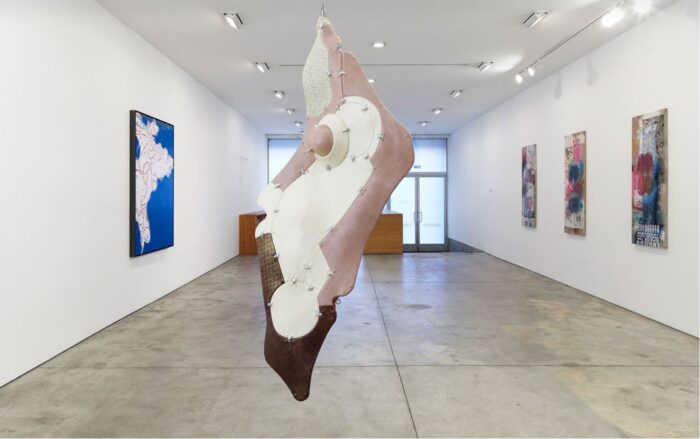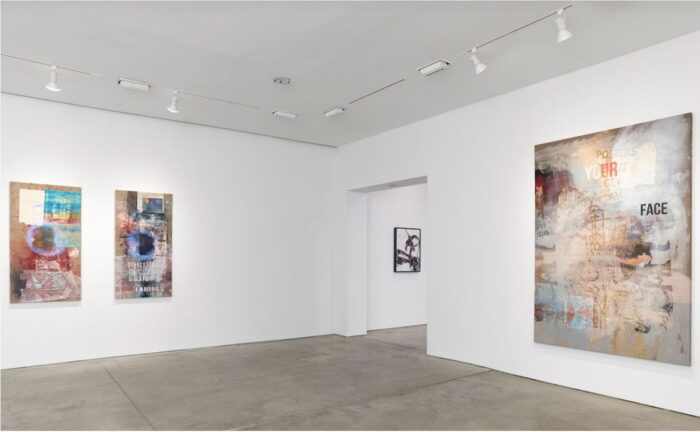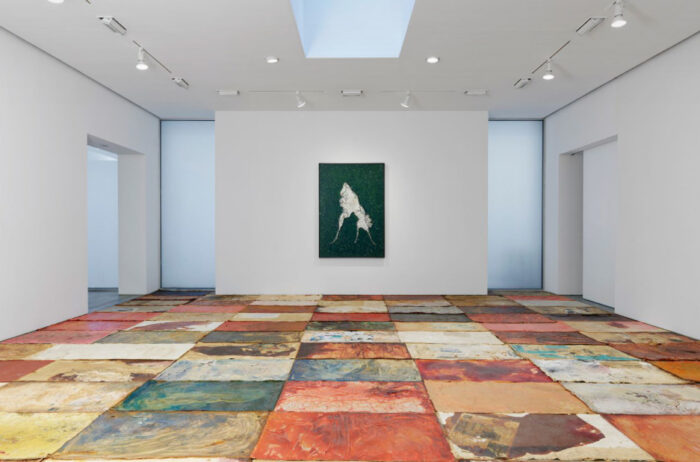Video walk-through of Mandy El-Sayegh & Lee Bul: Recombinance at Lehmann Maupin







Diptych, each: 55.12 x 28.37 inches| 140 x 72 cm
Mandy El-Sayegh & Lee Bul: Recombinance at Lehmann Maupin
25 Feb to 17 April , 2021
All Images courtesy of Lehmann Maupin
Lehmann Maupin is pleased to announce a joint exhibition featuring London-based artist Mandy El-Sayegh, and Seoul-based artist Lee Bul. Spanning two generations, both artists are known for their highly process-driven practices that often engage the human body through an exploration of materiality, science, literature, and medical technology. This exhibition will feature work from Lee Bul’s Perdu series and El-Sayegh’s recent Proofs series. While the Perdu series explores the binary of the technological and the organic, investigating the disruption of the natural by the artificial, El-Sayegh’s Proofs series examines the fragmented nature of human identification through the use of medical illustrations, imprints of the artist’s own body, and cultural and personal ephemera. Lee Bul’s work is the subject of a major solo exhibition Lee Bul: Saved Utopia at Manege Central Exhibition Hall, Saint Petersburg, Russia, while El-Sayegh’s work will be included in the upcoming exhibition British Art Show 9, organized by Hayward Gallery Touring, opening in 2021 in Wolverhampton, UK.
Born in the 1960s in South Korea under the country’s military dictatorship, Lee Bul came of age during a period of social and economic upheaval marked by the transition to a democratic state. The political shift experienced during her lifetime has informed much of her work and has been expressed in various ongoing themes, forms and materials over the course of her career, drawing inspiration from numerous literary, cinematic, and architectural sources. In her most recent Perdu paintings, composed of organic and inorganic material such as mother of pearl and layers of acrylic paint, the artist’s otherworldly visions of fragmented cyborg bodies are seemingly caught, suspended in space, at various distances and in differing detail. In Perdu LXIX (2020) the undefined forms emerge from a brightly-hued yellow field as if proliferating or expanding, hinting at an unidentified form of life that looms between the biological and technologic. The unfinished state of the forms and overall theme of physical and metaphorical yearning for completeness in the Perdu works is rooted in these past iterations where anagrams, like cyborgs, are formed from reconfigurable parts.
Mandy El-Sayegh’s process is rooted in a research-driven exploration of materiality, history, biology, and language. In her recent Proofs series, El-Sayegh explores fingerprint identification as a symbol of legitimacy and authenticity. Within each painting, the artist’s buttocks are imprinted over densely collaged surfaces, inviting us to consider the ways in which the female body is made, unmade, and circulated. The surfaces of the works are saturated with ink and imprinted with what the artist refers to as “thumbprints” of her body. Punctuated by collaged and silkscreened elements, as well as calligraphy by El-Sayegh’s father, the artist’s process erodes the meaning of common signifiers. Bringing together these de-contextualized appendages, El-Sayegh gives them a new body and sense of cohesiveness as an organic whole.
Drawing on El-Sayegh’s fascination with biological cell division, works like Proofs (bright enamel) (2021) present a fragmented female form, one historically shaped by medical illustration and analysis. Akin to cells sliced for microscopic inspection, the orbed prints are obscured by a series of meaning-making processes, each existing within their own temporalities. For instance, headlines are removed from their original sources and dispersed in seemingly nonsensical configurations. In certain works, El-Sayegh lists the code names of Israeli military operations from the 1990s, which, when translated into new typefaces, appear as imagined fashion collections from magazines. Meaning is dislocated from context, lost in a sea of newspaper clippings, image scraps, and signifiers. Read together, the works can be viewed as an organism structured through symbolic frameworks; an exploration of the body as it is translated through text and imagery.
Both Lee Bul and El-Sayegh engage in deep exploration of material and meaning, often through bodily and flesh-like imagery. Taken together, the works on view offer a compelling examination of external political issues, especially the broader construction of social and political systems.
About the Artists
Mandy El-Sayegh (born in 1985, Malaysia; lives in London) received her BFA in 2007 from the University of Westminster, London, followed by her MFA in painting in 2011 from the Royal College of Art, London. Solo exhibitions of El-Sayegh’s work have been organized at the Sursock Museum, Beirut, Lebanon (2019); Bétonsalon, Paris, France (2019); Chisenhale Gallery, London, United Kingdom (2019); The Mistake Room, Guadalajara, Mexico (2018); and Carl Kostyál, London, United Kingdom (2017). She has been featured in various group exhibitions including Searching the Sky for Rain, Sculpture Center, Long Island City, NY (2019); Ecologies of Darkness, SAVVY Contemporary, Berlin, Germany (2019); Deterioro y Poder, Instituto de Vision, Bogota, Colombia (2018); Lessons in Agronomy, Sifang Art Museum, Nanjing, China (2017); Boundary Work, Sharjah Biennial 13: Tamawuj, Sharjah, United Arab Emirates (2017); Room Services (with Oscar Murillo and Yutaka Sone), New York Art Book Fair at MoMA PS1, New York, NY (2016); For Pete’s Sake, Carl Kostyál, Stockholm, Sweden (2016); Elizabeth House, Elizabeth House, London, United Kingdom (2011); Responsive Eye, London Gallery West, London, United Kingdom (2011); and RCA Painting Degree Show, Royal College of Art, London, United Kingdom (2011). El-Sayegh’s work is in public and private collections, including Collection Nicoletta Fiorucci Russo, London; and Start Museum, Shanghai, China. In 2017 El-Sayegh was shortlisted for the Max Mara Art Prize for Women in collaboration with the Whitechapel Gallery, London and was invited to participate in the Chisenhale Gallery Commissions Programme 2017–19, supported by the LUMA Foundation.
Lee Bul received a BFA in sculpture from Hongik University, Seoul, in 1987. Solo exhibitions of her work have been organized at the Seoul Museum of Art, South Korea (2021, forthcoming) Manege Central Exhibition Hall, Saint Petersburg, Russia (2020; SCAD Museum of Art, Savannah, GA (2019); Hayward Gallery, London, United Kingdom (2018); Martin Gropius-BauArt, Berlin, Germany (2018); Art Sonje Center, Seoul, South Korea (2016 and 2012); Vancouver Art Gallery, Vancouver, Canada (2015); Palais de Tokyo, Paris, Frabce (2015); National Museum of Modern and Contemporary Art, Seoul, South Korea (2014); Musée d’Art Moderne Grand-Duc Jean, Luxembourg (2013); Mori Art Museum, Tokyo, Japan (2012); Fondation Cartier pour l’art contemporain, Paris, France (2007); Power Plant, Toronto, Canada (2002); New Museum, New York, NY (2002); and the Museum of Modern Art, New York, NY (1997). Her work has been included in important group exhibitions and biennials such as Phantom Plane, Cyberpunk in the Year of the Future, Tai Kwun Contemporary, Hong Kong (2019); Negotiating Boundaries, Korean Culture Centre UK, London, United Kingdom (2019); Cosmologic Arrows, Bonniers Konsthall, Stockholm, Sweden (2019); the 58th Venice Biennale (2019); Art in the Age of the Internet, 1989 to Today, Institute of Contemporary Art Boston, Boston, MA (2018); Score_ Music for Everyone, Daegu Art Museum, Daegu, South Korea (2017); X: Korean Art in the Nineties, Seoul Museum of Art, Seoul, South Korea (2016); The future is already here – it’s just not very evenly distributed, 20th Biennale of Sydney (2016); Contemporary Art at the Guggenheim, Solomon R. Guggenheim Museum, New York, NY (2015); Burning Down the House, 10th Gwangju Biennale, Gwangju, South Korea (2014); Prospect 1: A Biennial for New Orleans, New Orleans, LA (2008); Not Only Possible, But Also Necessary: Optimism in the Age of Global War, 10th International Istanbul Biennial (2007); and dAPERTutto, 48th Venice Biennale (1999). Her work is in numerous international public and private collections, including the Los Angeles County Museum of Art, Los Angeles, CA; M+, Hong Kong; Mori Art Museum, Tokyo, Japan; Museum of Fine Arts, Houston, TX; National Gallery of Victoria, Melbourne, Australia; National Museum of Modern and Contemporary Art, South Korea; Seoul Museum of Art, South Korea; the Solomon R. Guggenheim Museum, New York, NY; Tate Modern, London, United Kingdom; and Walker Art Center, Minneapolis, MN. In 2019, Lee Bul received the Ho-Am Prize for The Arts, which is awarded to people of Korean heritage who have contributed to the enrichment of culture and arts for humankind. In 2014, she received the Noon Award at the 10th Gwangju Biennale, given to an established artist who has produced the most experimental work that embodies the theme of the biennale. In 1999, Lee Bul was awarded an honorable mention at the 48th Venice Biennale for her contribution to both the Korean Pavilion and the international exhibition curated by Harald Szeemann.
